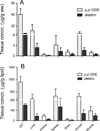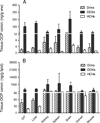Tissue distribution of organochlorine pesticides in largemouth bass (Micropterus salmoides) from laboratory exposure and a contaminated lake
- PMID: 27394080
- PMCID: PMC5014564
- DOI: 10.1016/j.envpol.2016.06.061
Tissue distribution of organochlorine pesticides in largemouth bass (Micropterus salmoides) from laboratory exposure and a contaminated lake
Abstract
Tissue concentrations of persistent organochlorine pesticides in laboratory-exposed largemouth bass (Micropterus salmoides) and in bass collected from Lake Apopka, FL were determined by both total mass and lipid normalized mass to better understand the bioaccumulation pathways of contaminants. In the laboratory study, male bass were orally administered a single dose of a mixture of two pesticides (p,p'-dichlorodiphenyldichloroethylene (p,p'-DDE) and dieldrin) and then fed uncontaminated food for 28 days. Gastrointestinal tract, liver, brain, gonad, kidney, spleen, and muscle were collected for chemical analysis. Different profiles were observed by total contaminant mass in tissues compared to lipid normalized mass. On a lipid normalized basis, p,p'-DDE was highest in the gastrointestinal tract followed by the liver, gonad, spleen, muscle, kidney and then brain. Dieldrin, on the other hand, was highest in the gastrointestinal tract and spleen and then followed by the gonad, muscle, liver, kidney, and brain. Distribution of the chemicals among the organs differed by their log KOW values and generally followed the blood flow path after the gastrointestinal tract. The low contaminant levels found in kidney and brain suggest insufficient time for equilibration into these tissues, especially into the brain where the blood-brain barrier may be slow to traverse. In Lake Apopka fish, dichlorodiphenyltrichloroethanes (DDXs, sum of p,p'-DDE, p,p'-DDD, and p,p'-DDT), Drins (sum of aldrin, dieldrin, and endrin), and hexachlorocyclohexanes (HCHs) were found. For DDXs, the lipid normalized concentrations in each tissue were about the same, as predicted from theory. For Drins and HCHs, the lipid normalized concentrations were similar for kidney, spleen, brain, gonad and muscle, but much lower in the gastrointestinal tract and liver, probably because of metabolism occurring in those tissues.
Keywords: Lake Apopka; Largemouth bass; Oral dosing; Organochlorine pesticides; Tissue concentration.
Copyright © 2016 Elsevier Ltd. All rights reserved.
Figures



Similar articles
-
Transcriptional networks associated with the immune system are disrupted by organochlorine pesticides in largemouth bass (Micropterus salmoides) ovary.Aquat Toxicol. 2016 Aug;177:405-16. doi: 10.1016/j.aquatox.2016.06.009. Epub 2016 Jun 17. Aquat Toxicol. 2016. PMID: 27391359
-
Concentrations and potential health hazards of organochlorine pesticides in (shallow) groundwater of Taihu Lake region, China.Sci Total Environ. 2014 Feb 1;470-471:1047-55. doi: 10.1016/j.scitotenv.2013.10.056. Epub 2013 Nov 14. Sci Total Environ. 2014. PMID: 24239826
-
Depth-distribution, possible sources, and toxic risk assessment of organochlorine pesticides (OCPs) in different river sediment cores affected by urbanization and reclamation in a Chinese delta.Environ Pollut. 2017 Nov;230:1062-1072. doi: 10.1016/j.envpol.2017.06.068. Epub 2017 Aug 10. Environ Pollut. 2017. PMID: 28764122
-
Pesticides in the hydrogeo-environment: a review of contaminant prevalence, source and mobilisation in India.Environ Geochem Health. 2023 Aug;45(8):5481-5513. doi: 10.1007/s10653-023-01608-6. Epub 2023 May 15. Environ Geochem Health. 2023. PMID: 37183216 Free PMC article. Review.
-
Organic contaminants in bats: trends and new issues.Environ Int. 2014 Feb;63:40-52. doi: 10.1016/j.envint.2013.10.009. Epub 2013 Nov 19. Environ Int. 2014. PMID: 24263138 Review.
Cited by
-
Organochlorine pesticides: Agrochemicals with potent endocrine-disrupting properties in fish.Mol Cell Endocrinol. 2020 May 1;507:110764. doi: 10.1016/j.mce.2020.110764. Epub 2020 Feb 26. Mol Cell Endocrinol. 2020. PMID: 32112812 Free PMC article. Review.
-
Health risk assessment and heavy metal accumulation in fish species (Clarias gariepinus and Sarotherodon melanotheron) from industrially polluted Ogun and Eleyele Rivers, Nigeria.Toxicol Rep. 2021 Jul 14;8:1445-1460. doi: 10.1016/j.toxrep.2021.07.007. eCollection 2021. Toxicol Rep. 2021. PMID: 34401354 Free PMC article.
-
Low Dose of Nickel and Benzo [a] Anthracene in Rat-Diet, Induce Apoptosis, Fibrosis, and Initiate Carcinogenesis in Liver via NF-Ƙβ Pathway.Biol Trace Elem Res. 2025 Jan;203(1):305-333. doi: 10.1007/s12011-024-04177-6. Epub 2024 Apr 24. Biol Trace Elem Res. 2025. PMID: 38656682
-
Assessment of biochemical biomarkers and environmental stress indicators in some freshwater fish.Environ Geochem Health. 2024 Oct 3;46(11):464. doi: 10.1007/s10653-024-02226-6. Environ Geochem Health. 2024. PMID: 39361177 Free PMC article.
References
-
- Bligh EG, Dyer WJ. A rapid method of total lipid extraction and purification. Can. J. Biochem. Physiol. 1959;37:911–917. - PubMed
-
- Boon JP, Oostingh I, van der Meer J, Hillebrand MTJ. A model for the bioaccumulation of chlorobiphenyl congeners in marine mammals. Eur. J. Pharmacol. 1994;270:237–251. - PubMed
-
- Bruijn JD, Busser F, Seinen W, Hermens J. Determination of octanol/water partition coefficients for hydrophobic organic chemicals with the “slow-stirring” method. Environ. Toxicol. Chem. 1989;8:499–512.
-
- Clark KE, Gobas FA, Mackay D. Model of organic chemical uptake and clearance by fish from food and water. Environ. Sci. Technol. 1990;24:1203–1213.
MeSH terms
Substances
Grants and funding
LinkOut - more resources
Full Text Sources
Other Literature Sources
Medical
Research Materials
Miscellaneous

